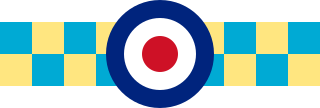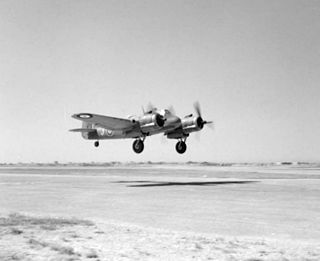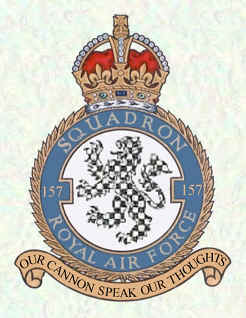
No. 138 Squadron RAF was a squadron of the Royal Air Force that served in a variety of roles during its career, last disbanded in 1962. It was the first 'V-bomber' squadron of the RAF, flying the Vickers Valiant between 1955 and 1962.
No. 635 Squadron RAF was a heavy bomber squadron of the Royal Air Force during the Second World War.
No. 515 Squadron RAF was a squadron of the Royal Air Force formed during the Second World War. It ushered in Electronic countermeasures (ECM) warfare, jamming enemy radar installations from October 1942 as the only such squadron in the RAF initially. Later in the war 515 Sqn was joined by other squadrons as part of No. 100 Group RAF. The squadron disbanded after VE day, when the need for such a specialised squadron had reduced.
No. 695 Squadron RAF was an anti-aircraft co-operation squadron of the Royal Air Force from 1943 to 1949.

No. 245 Squadron was a squadron of the Royal Air Force. It flew as an anti-submarine squadron during World War I and as a fighter squadron during World War II. After the war it was first a jet-fighter squadron and its last role was as a radar-calibration unit.
No. 193 Squadron RAF was a fighter squadron of the Royal Air Force during World War II.
No. 684 Squadron RAF was a photo-reconnaissance squadron of the Royal Air Force from 1943 to 1946.
No. 595 Squadron RAF was a squadron of the Royal Air Force from 1943 to 1949.
No. 626 Squadron RAF was a heavy bomber squadron of the Royal Air Force from 1943 to 1945.
No. 513 Squadron RAF was a non-operational bomber squadron of the Royal Air Force in 1943.

No. 358 Squadron RAF was a Bomber and Special duties squadron of the Royal Air Force flying with South East Asia Command from 1944 to 1945.

No. 235 Squadron RAF was an anti-submarine warfare squadron of the Royal Air Force which disbanded during July 1945. It was active in both the First World War, forming during August 1918 and disbanding in February 1919, and in the Second World War, reforming at the end of October 1939, and served as a squadron in RAF Coastal Command.
No. 570 Squadron RAF was a bomber unit active within No. 38 Group RAF as an airborne, bomber support and special operations squadron during World War II.
No. 293 Squadron was a Royal Air Force air-sea rescue squadron. During the Second World War the unit operated search and rescue missions for Allied aircraft operating over Italy.
No. 571 Squadron RAF was a Second World War Royal Air Force pathfinder squadron operating the de Havilland Mosquito.
No. 524 Squadron was a Royal Air Force Coastal Command aircraft squadron that operated during the Second World War.

No. 627 Squadron was a Royal Air Force Mosquito aircraft pathfinder bomber squadron that operated during the Second World War.
No. 527 Squadron RAF was a radar calibration unit of the Royal Air Force between 1943 and 1958.
No. 529 Squadron RAF was a radar calibration unit of the Royal Air Force during World War II. The unit had the distinction to be the only RAF unit to fly autogyros and helicopters operationally during World War II.

No. 157 Squadron RAF was a Royal Air Force Squadron active as a night fighter unit in the Second World War.






